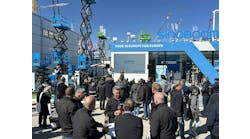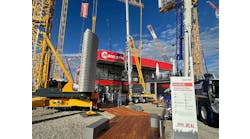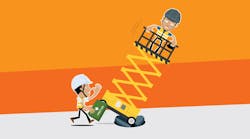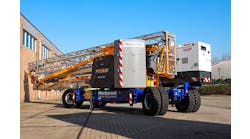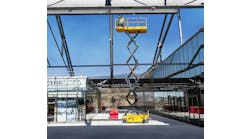Interview with Snorkel’s Matthew Elvin: Heavy Duty Applications
RER: What are the latest safety developments from your company?
Elvin: Safety remains at the heart of everything we do at Snorkel, and this is evidenced in the latest product developments which were previewed earlier this year. The new Snorkel 2100SJ, the world’s largest self-propelled telescopic boom lift, will include a number of brand-new features that will help to drive new standards of operator safety.
In the platform, a patent-pending secondary control panel has been designed to enable the operator to face the work area while positioning the platform, for safer operation and increased precision. The new secondary control panel, which provides all machine functions other than drive, is located on the opposite side of the platform to the primary controls and can be ‘folded away’ into a stowed position when not in use to maximize the platform working area and to protect it from damage. Both the primary and secondary controls include Snorkel Guard secondary guarding systems.
Simplicity is key in the dual zone management system, which is based on jib boom extension, rather than on the platform load, delivering a simple, single envelope. This means that when the 30-foot jib boom is retracted, the operator has a platform capacity of 1,000 pounds, but the when the jib boom is extended, the platform capacity is reduced to 660 pounds.
While this system provides a much simpler experience for the operator, Snorkel has also added haptics to its upper controls. This provides the operator with a joystick vibration experience that becomes proportionally stronger to warn the operator as they near the boundaries of the envelope, to avoid sudden stops when working at height.
For safer loading and unloading, the Snorkel 2100SJ is equipped with a removable RF-controlled lower control panel designed to be operated remotely, either tethered or wireless. The remote-control panel has all machine functions, including drive, and the panel can be easily stowed inside the turntable where it can be used as conventional fixed lower controls.
What impact has COVID-19 had on your business and what do you expect going forward?
We have experienced a similar magnitude of impact from COVID-19 as most other equipment manufacturers have reported. We are starting to see signs of people returning to their business operations in some regions. As you would expect, business, and demand, is returning more quickly in countries where COVID-19 has been minimized.
What have been the latest developments in your company’s product line in the past year?
We have a lot going on in terms of product development. Unsurprisingly, our largest latest development is the new Snorkel 2100SJ mega boom, the world’s largest self-propelled boom lift. Capable of reaching a maximum working height of 216 feet, the equivalent of 22 building stories, the new 2100SJ also provides an industry-leading outreach up to 100 feet, and an unrestricted platform capacity of 660 pounds.
Developed in-house, the 2100SJ features patent-pending static axle transformation, which uses wheel motors to ‘drive’ the axles into their extended position, minimizing the risk of tire scrub, extending the tire life and providing a smoother experience for the operator. The Snorkel 2100SJ also boasts incredible maneuverability, with an 8 foot 6 inch inside turning radius and five steering modes, including lateral steer, which enables the lift to drive side-to-side along a building with the wheels in a 90° position.
Compliant with all global standards, the Snorkel 2100SJ has transport dimensions of 8 feet, 2 inches wide and 49-foot length, and for safer loading, is equipped with a removable RF-controlled lower control panel designed to be operated remotely, either tethered or wireless.
Weighing 80,000 pounds, and rated for outdoor use up to 28 mph, it is equipped with an anemometer to measure wind speeds. The Snorkel 2100SJ has redundant, isolated, emergency power supplies to provide at least three alternative options to rescue an operator up to the maximum platform height.
Shown as a preview at CONEXPO-CON/AGG 2020, the Snorkel 2100SJ is scheduled to enter production in early 2021, and pre-orders are currently being accepted, with the first units already sold to customers in Canada, the U.K. and the U.S.
Although somewhat overshadowed by the 2100SJ, Snorkel has also taken a larger step into the expansion of our scissor lift offering this year. At CONEXPO-CON/AGG 2020, we unveiled the first models in two new families of rough terrain construction scissor lifts. Designed for heavy-duty applications, the two new families include three high capacity large deck models, and a family of four ultra-high capacity large deck models.
The largest scissor lift in the new ultra-high capacity range is the Snorkel S9070RT-HC, which is setting new industry standards for construction-grade scissor lifts from a full-line manufacturer, with class-leading lift height and lift capacity. With a maximum working height of 76 feet and a lifting capacity of 2,000 pounds, the S9070RT-HC comes equipped with dual-powered extension decks and four hydraulic stabilizers with automatic levelling as standard.
Dubbed a ‘mega’ scissor, the S9070RT-HC delivers a maximum platform size of 27 feet x 7 feet, 6 inches when fully extended, designed to provide a vast working area and help to reduce the number of times the operator needs to lower and elevate the lift. With material loading in mind, this scissor lift family was designed with an integrated double material loading gate on the platform to allow a full-size pallet to be placed directly onto the deck. This makes the loading of materials onto the lift both safer and more efficient, as the correct material handling equipment can be used. Both scissor lift families are on schedule to enter full production in 2021.
We have also been expanding our Snorkel telehandler line, with two new models that are currently available to order. The diesel-powered SR1331 has a maximum lift capacity of up to 13,000 pounds, and a maximum lift height of up to 31 feet, 2 inches, and is the largest capacity telehandler in the Snorkel line-up currently. This year, we also introduced the new SR5719E, the world’s first electric telehandler, powered by lithium-ion batteries. Completely zero emissions, this compact rough terrain telehandler delivers equivalent performance to the diesel version, yet with significantly less noise, making it ideal for both indoor and outdoor material lifting applications.
Lithium-ion batteries are providing a real alternative to diesel in certain product categories, and we have continued to roll out this technology. In late 2019, we introduced two lithium-ion battery powered versions of our popular Speed Level sigma lifts, and this is being followed by three compact rough terrain scissor lift models that will enter production later this year. We have plans to continue expanding our lithium electric product offering, with our two narrow compact rough terrain scissor lift models next year, as well as mid-size booms.
Finally, in the diesel mid-size telescopic boom lift category, we introduced a tracked version of our 600S and 660SJ booms earlier this year. Delivering enhanced traction, the ‘All Terrain’ models feature a full-time active oscillating axle and four independent rubber tracks which can traverse uneven terrain without sinking into loose sediment, soft soil, sand, snow or mud.
What have been the most important recent trends in aerial product development and what trends look most important in the near future?
A long-term trend in the equipment sector, including aerials, is the move towards alternative power sources to diesel. This continues to be a growing area within product development, and we expect to see it continue throughout the next decade. While some solutions have been relatively quick to bring to market, such as our own introduction of lithium-ion battery powered compact scissor lifts and compact telehandlers, the continued introduction of electric power solutions will be dependent on having the necessary technology to deliver diesel-equivalent performance that is both affordable and practical. This will become more difficult to achieve on larger and heavier units.
A recent, and continuing trend, in North America is to find solutions that help mitigate some of the challenges experienced by operators through the new ANSI A92.20 design standards. This can be related to dimensional challenges, such as guardrail height, where we have developed innovative solutions, such as the Snorkel S3019E with its stowed scissor stack delivering a low stowed height to pass through doorways without requiring folding guardrails. It can also relate to the new indoor/outdoor ratings, where we have developed our new variable angle system, which provides an outdoor rated machine that requires no selection of intervention from the operator.
The variable angle system, fitted to all new Snorkel electric slab scissor lifts, complies with the new standard for outdoor rating and full capacity at all lift heights of the scissor lift, by reducing the permitted side-slope angle as the stack is elevated. This actually allows increased flexibility of the machine at “less than full height” work.
Other trends that we are seeing include the continued demand for greater lift capacity, which we are addressing through the introduction of our two new families of large deck construction scissor lifts, and we are also working on higher capacity options for our mid-size telescopic boom lifts, with the introduction of a new jib boom.
Now that new ANSI standards have become a reality, how would you assess the impact they are having so far? How are customers adapting to newer machines with load-sensing technology, terrain-sensing, indoor/outdoor restrictions and so on?
In all honesty, COVID-19 has delayed the real impact of the new ANSI standards. Many rental companies across the U.S. have reduced their purchasing of new equipment and/or delayed accepting new equipment deliveries due to a reduction in demand from their customer base. As such, there is a minimal quantity of the new ANSI-compliant lifts in the field, meaning that customer feedback at this stage has been somewhat limited. We won’t see the full impact until more of the market returns to more ‘normal’ operations.
What level of demand are you seeing for electric MEWPs, hybrids, alternative fuels?
Demand for alternative fuel options to diesel is increasing, but the speed of adoption is regional and is based on market dynamics, such as the availability of financial incentives and/or environmental regulations on noise and emissions, either implemented by the local authorities or the jobsites themselves. At Snorkel, we believe that this is a long-term growth area, and we are continuing to develop our line of lithium-ion battery-powered lifts that provide a real alternative to diesel-powered lifts.
How do you see adoption of telematics systems changing the rental industry?
I’m not sure that telematics will change the rental industry necessarily, but rather be embraced as another tool that can assist in the optimization of rental operations, such as equipment maintenance, pick-ups and deliveries, and much more.

